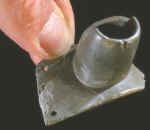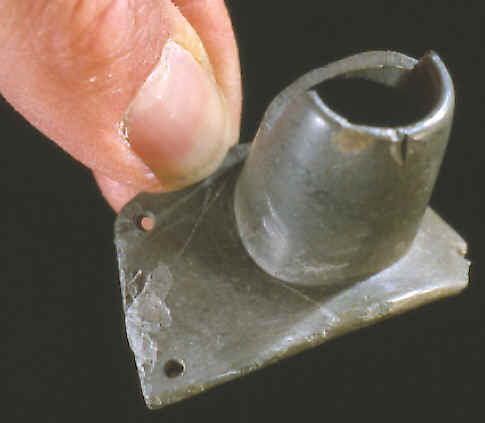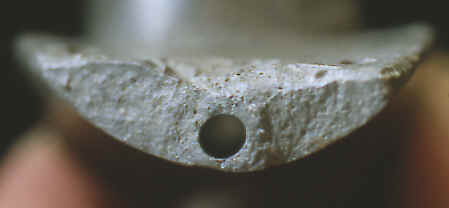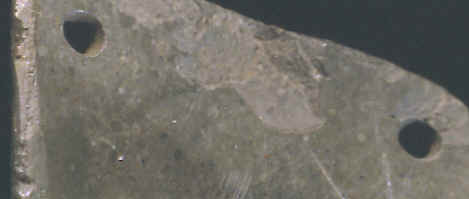|
A REPAIRED HOPEWELL
PLATFORM PIPE

RANDOLPH
COUNTY, ILLINOIS
MARY MATHEWS
COLLECTION
|
|
PLATFORM PIPE
MIDDLE WOODLAND HOPEWELL CULTURE
RANDOLPH COUNTY, ILLINOIS
MARY MATHEWS COLLECTION
Mary Mathews found this interesting stone pipe in a cultivated field
in Randolph, County, Illinois several years ago. It's been roughed
up a bit from agricultural implements but the heaviest damage
evidently occurred prehistorically. The old damage is what makes this
artifact so interesting. |
|

CLICK ON
PICTURE FOR VERY LARGE IMAGE
A REPAIRED HOPEWELL PLATFORM
PIPE
RANDOLPH COUNTY, ILLINOIS
MARY MATHEWS COLLECTION
The attempt at repair is obvious. Two holes were drilled on each
side of the bowl near the breaks. |
|
|
Prehistoric repair of broken ceramic bowls, ground stone objects like
gorgets and even flaked "ceremonial" bifaces is evident
from drilled holes and notches cut around the breaks of these artifacts.
Attempts at repair is evident on Stone Age artifacts all across North
America. |
|

CLOSE-UP OF THE STEM HOLE
BROKEN HOPEWELL PLATFORM
PIPE
RANDOLPH COUNTY, ILLINOIS
MARY MATHEWS COLLECTION
Hopewell
pipe stem holes are fairly small in diameter as can be seen in this
picture of the broken end of this repaired pipe. The holes are
straight sided unlike stone drilled holes which are conical. These
holes were probably drilled with a hollow cane along with water and
a fine stone grit. |
|
|
It's
odd that this Hopewell pipe was so badly broken with both ends broken
off. This type of break pattern is often seen on some Hopewell pipes
that have been excavated from mounds where they were prehistorically
placed as burial offerings. One possibility is that this pipe was
recovered anciently from a mound and the individual attempted to use it
once again by reattaching the broken parts. |
|

REPAIR HOLES
BROKEN HOPEWELL PLATFORM
PIPE
RANDOLPH COUNTY, ILLINOIS
MARY MATHEWS COLLECTION
This picture shows two of the four repair holes on this pipe. |
|
|
How this pipe was broken, no one will ever know. But it appears that an
attempt at repair was made. Evidence of this is indicated by the two
holes that were drilled on the edges of both breaks. The broken ends,
that have not been found, probably had corresponding holes that allowed
them to be tied back together. The repair may also have been aided with
the application of some type of natural adhesive that may have been
either animal, vegetal or mineral in origin. Capt. John Smith reported
that "with sinew of deer and the tops of deer horns boiled to a
jelly the Virginia Indians made glue that would not dissolve in cold
water. |
|
"REFERENCES"
1912, "Handbook of North American Indians, North of Mexico", by
Frederick Webb Hodge, p. 226.
|
|
HOME
ORDERING |